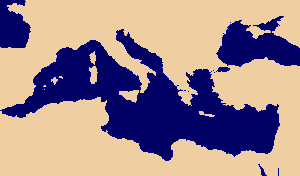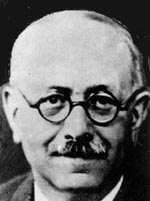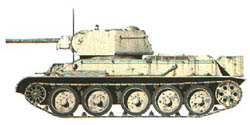Understanding History
Longer EventsNot everything is on the time scale of the five or ten seconds required for the beheading of Mary Queen of Scots. We here take a look at some of the things that have a longer span, though they too, arguably, belong to the province of history.
The Shan-jing, a Chinese economic resource text of the 04th century, makes weird reading, because in all its peregrinations through the mountains and rivers known to the Chinese of that time, there is never a mention of man, nor any artifact of man. There are no cities, no walls, no memories of exploits. It might be the landscape of the moon. It reduces the map to its lowest and least himan terms: a terrain at some points of which valuable things may be found. And a number telling how far it is to the next such place.
If, in that manner, we reduce the map of the Mediterranean to its geographical lowest terms, we get a stunning insight into the interconnection of Greece, Rome, Carthage, Egypt, and Anatolia. We find that the terms of Mediterranean history were fixed even before there were human beings in the Mediterranean area. And if we close the focus slowly, not zooming direct to court history, but scrolling first through slower trends and changes, there come into view things like climate tendencies, the limits of cultivation with given tools, the character of economies without central banking, the strategies of the larger population in times of famine. This is the grand panorama. Under the name of "Annales history" (named for the journal founded in 1929 by Lucien Febvre and Marc Bloch), paying attention to it is an important movement within European history. Another key term of this movement is "mentalities," the study of the mindsets of peoples and times; the slower and less volatile counterpart of intellectual history.
The Annales movement and its works suffer from their combative origins as reactions to court history. In much the same way, all extensions of history are scarred by departmental feuds, disciplinary divisions, and the rest of the tensions and polarizations to which the academic "mentality" is eternally prone. All that, in the long view of history, is mere court history; the sqabbles of insignificant persons. The long view, or as the Annales folk call it, the "longue durée," is ineradicably part of the whole view. No matter who may fuss.
Though the Mediterranean was the focus of this insight as it developed in the study of Europe, there are other ways in which it could, or did, emerge. The extreme example of court history is the Chinese chronicle called the Spring and Autumn, kept at Lu from 0721 onward (our surviving text stops at 0481). It records diplomatic events and wars; the doings and movements of the ruling house. Barely visible beyond those entries is the rural substrate: good or bad harvests, insect plagues, freaks of unseasonable weather, famines. Analysis is capable of revealing still more. If we leave out all detail except what suggests wet or dry years, and analyze that, we find that moist and dry climate periods alternated in a cycle of approximately 60 years' duration. And it turns out that these ups and downs coincide rather well with climate fluctuations evidenced by the sediments in West Asian lakes. That is, a single global desiccation rhythm is visible at both ends of the continent.
Who cares? Well, even those who like only the fighting side of history will be interested to know that the attack of the northern Di peoples on the capital of Wei, which eventually forced the relocation of the capital of Wei, was not necessarily due only to the caprice or evil nature of the Di people. It may also have had something to do with the Di being displaced from their usual grazing lands by a desiccation phase, and pressing in consequence upon the Sinitic zone just south of them. This is a type of explanation which is utterly unknown to traditional Chinese historiography.
Marc Bloch also emphasizes the persistence of human patterns, and their importance for historiography in a culture which above all else esteems change, and explanations based on change:
Man spends his time devising techniques of which he afterwards remains a more or less willing prisoner. What traveler in northern France has not been struck by the strange pattern in the fields? For centuries, changes in ownership have modified the original design, yet, even today, the sight of these inordinately long and narrow strips, dividing the arable land into a prodigious number of pieces, is something which baffles the scientific agriculturalist.
We are not responsible for bafflement in the School of Agriculture. But it is the job of historians not to be baffled. Noticing the time dimension, seeing where things were a year or a hundred years before, is one way not to be baffled.
The Medium Durée
Even when we zoom in to events in the usual sense, we do well to keep the nonimmediate in mind. Events, even as events, are most fully understood in that context. The use of oil for fuel immediately redrew the resource map of the world, and shaped every war, and contexted every individual act of war heroism, that came afterward. A history of war without the history of fuel is like a Punch and Judy show without the words: you have the color but not the meaning. Similarly, reading a history of war that does not include a history of industrial design is like watching the battle of Kursk, and being astonished at the excellence of the Russian T-34 tank, appearing suddenly over a ridge. But tanks are not crocuses, that spring overnight from the brow of Nature; they have a long aetiology. Who designed the T-34, and who gave the order for its production? They, it may be argued, and not the front line generals or the behind the lines partisans, are the real victors of the Eastern Front. No book on the Eastern Front mentions them, which is to say that the historiography of WW2 is still in the infant stage. It is incapable of digesting solid food, and is subsisting on mashed banana.
Sooner or later, more will be required.
Books on Alexander's campaigns proliferate on the shelves like flies. Donald Engels, in studying the prior question of how Alexander fed his soldiers on those campaigns, broke new ground. He showed the unseen logistic genius of Alexander, without which his tactical genius would not exist to be written about. And everyone can see the foolishness of Marie Antoinette's "let them eat cake" remark, but who has given serious thought to how ordinary Greeks in classical times made do in times of famine? Thomas Gallant, for one, and we commend his example also to wider consideration.
These topics, it will be seen, invite quantitative treatment. Calories per day per man, and how much they weigh on the back of a mule, and how much the mule itself consumes on the way to the next day's camp. (Now we know why early China tried to create self-sustaining military colonies on its borders, and why mediaeval China continued that experiment). Calories per day per woman and child, and how many calories the husband and father needs to expend in gathering them from the sea when the field crop fails. (The ratio happens to be against the husband). Weight of shell, and speed at which the gun platform firing that shell can be delivered to firing position. That sort of thing.
Historians have traditionally been averse to things that require counting. One sometimes feels that historians are recruited chiefly from those who flunked first year calculus. But no rational person would try to get through ordinary life without balancing their checkbook every month, and no thoughtful historian should try to understand the past without being ready to deal with the countable part of the past: the Han government's plan to maneuver with the market price of grain; the sequestration of wealth in temples which motivated the Tang suppression of Buddhism; whatever. The government officials of the time knew the score. They kept the score. Can the observer, the watcher from a future century, afford to know less than they did?
A manual should give answers to its own questions. This manual will now proceed to give the answer to the question about the Russian T34 tank. The answer to that question is three people. (1) In 1928, the American J Walter Christie demonstrated a radically new tank suspension, making possible fast off-road speeds. (Christie had good speed credentials, having competed in the on-road 1906 Vanderbilt Cup in a 50hp Christie automobile of his own radical front-wheel drive design). Despite favorable recommendations from observers such as the young Patton, the American military never came to terms with Christie; his plans didn't match their preconceived specs. He went elsewhere. A Russian fast tank based on Christie's design, the BT-2, was first tested in 1932. Further experience, and the guidance of a design team headed by (2) Mikhail Koshkin, who, over the opposition of colleagues, gained (3) Stalin's permission to develop something beyond the preconceived specs of the Russian procurement authorities, led to the T-34, first produced in September 1940. It retained the Christie suspension as a platform for Koshkin's further innovations. The outbreak of war with Germany in June 1941 halted further modifications and led to mass production of the existing design.
The battle of Kursk, an attempt by both sides to break the Eastern Front stalemate, opened on 4 July 1943. It was and remains the largest tank battle ever fought. It can without undue exaggeration be identified as the turning point of the European phase of WW2. And the T-34 was among the decisive factors in the outcome. Said German general von Mellenthin, "We had nothing comparable."
Neither, at that date, despite early opportunities to rethink their preconceptions, did the Americans. One thing about stupidity: there is always enough of it to go around. Does anybody want to hear the story of the American torpedoes in the Pacific War? No? Just as well. The parts of the story that come from the men at the fighting front include some profanity.
Readings
- Fernand Braudel. La Méditerranée et le Monde Méditerranéen a l'Époque de Philippe II. 3v 1949f
- Donald W Engels. Alexander the Great and the Logistics of the Macedonian Army.
- Thomas W Gallant. Risk and Survival in Ancient Greece.
- François Dosse. The New History in France: The Triumph of the Annales. Illinois 1994
- Martin Caidin. Kursk.
- Friedrich W von Mellenthin. Panzer Battles.
7 Nov 2000 / Contact The Project / Exit to Outline Index Page



